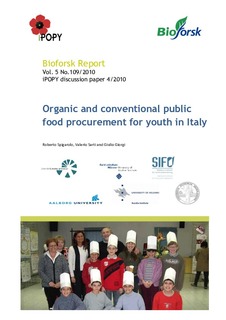| dc.description.abstract | This report describes the political organisation and policies about public organic procurement in Italy, especially within school catering, and how organic products are utilized in this sector. The report is produced within the project “innovative Public Organic food Procurement for Youth”, iPOPY, and is a revised version of a preliminary report published in the same report series in 2008. Organic and otherwise typical and certified food is supported by several Italian regions by regulations and guidelines demanding that municipalities must prioritize such food in their calls for tenders. This has contributed to make Italy a leading public consumer of organic food, serving about 1 million dishes of school food per day with at least some organic ingredients. In total, about 40% of the food consumed in Italian schools is organic, and 36% from otherwise certified agriculture (local speciality, integrated or fair trade). On full length school days, all pupils are served a warm meal with two dishes, commonly also a desert. The average payment is 3.86 Euro. Future challenges for the Italian school meals with their high share of organic food are to reduce the high amounts of food waste, partly incurred by the current system of food serving where all pupils get equal portions, served at a table. Further, non-food costs are a challenge, as they constitute 70 % of the total food costs. Means to ensure that municipalities and caterers follow the regional guidelines are also required, as well as support for the municipalities to design efficient calls for tenders. The communication about organic food in schools, e.g. as a part of the education, should be strengthened to increase the pupil’s understanding of the benefits of this farming practice for the environment. | nb_NO |
